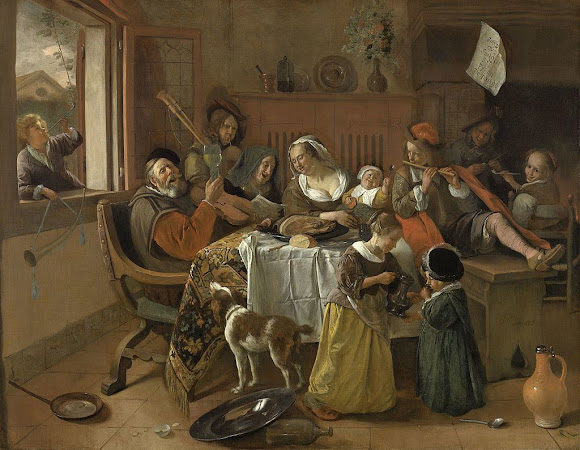Baroque
Baroque
Jan Steen was a Dutch painter who lived during 1626-1679. He was taught paining in school by the German painter Nicolaes Knupfer and you can see the influences of Knupfer in Steens work with the composition and color. He later married to have eight children and founded a painters guild where he worked for five years until an explosion caused the art market to collapse afterwards he ran a tavern until his death.
Art Analysis
This baroque genre painting can be identified by the moment in time scene, realistic character designs and especially the dramatic effect of light in the painting. The scene consists of boisterous father and melodies played by the instruments of his children around a dinner table. The moral of the picture, as given away by the note hanging from the mantelpiece reading "So de ouden songen, so pijpen de jongen" ("as the old sing, so shall the young pipe"), is that children will learn their codes of behaviour from their parents.
Art relation to The Thirty Years War
The war lead to great devastation with a death range of 4.5-8 million primarily to disease or starvation. The terror of the war ending in 1648 made lasting trauma of food scarcity across the country that probably lasted a few generations. I could see how this would cause people to celebrate dinner with family and how an already traditional ceremony could become more meaningful to the point genre paintings were made to encapsulate the everyday beauty of such activities.
Painting Comparison to Renaissance paintings
A renaissance style painting I would compare to the baroque painting above would be
A renaissance style painting I would compare to the baroque painting above would be
Andries van Bochoven, Portrait of the painter Andries van Bochoven and his family. The stark differences between these two are exactly what makes Jan Steens scene a Baroque and Bochovens a renaissance style painting. I stated above Jan Steens painting had realistic characters and was a movement captured in time. Bochovens painting, also consisting of a family having dinner consits of idealized characters posed in serenity, the colors and the effect of lighting are the same as well but you can clearly see in Jan Steens his use of shadows in corners of the room in his scene versus Andries van Bochoven equally balanced effect of lighting across the scene.
Andries van Bochoven, Portrait of the painter Andries van Bochoven and his family, (1629). oil on paint
Works Cited





Of all the Baroque works that I have seen recently, I was quite surprised when I saw this one, as most of them use dark colours. In comparison to other works during this era, the chiaroscuro within this painting isn't as prominent, giving it a less dramatic contrast illusion. I also really like how this painting captures a moment where everyone appears to be celebrating cheerfully regardless of the traumatic experiences ongoing during the Thirty Year War, and how traditions can still remain meaningful. I wonder if this is a simple gathering of one family, or just several people together. Nice work!
ReplyDeleteWhile the lightning in this painting may not be exceptionally dramatic, I am a big fan of the muted colors in this piece. They remind me of a late summer/early fall day. Another thing that I noticed in relation to your point about the Thirty Years War is how even though the family is gathered at a table, there isn't much food pictured in the painting, and the table is surrounded by empty pots, pans, and pitchers. While it is possible that the family had already eaten, this could also be a statement regarding the widespread famine during the time period. Overall, I think this is a really interesting painting, thank you for sharing it!
ReplyDelete